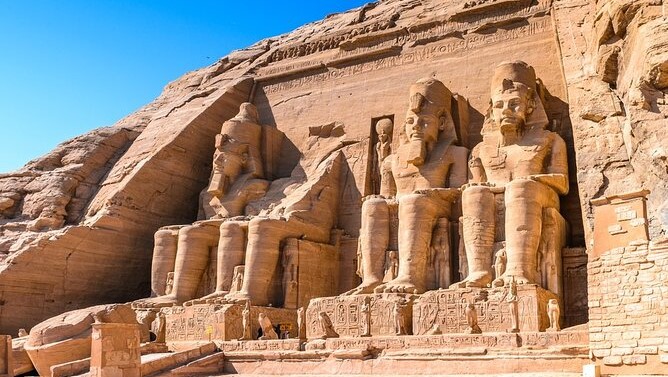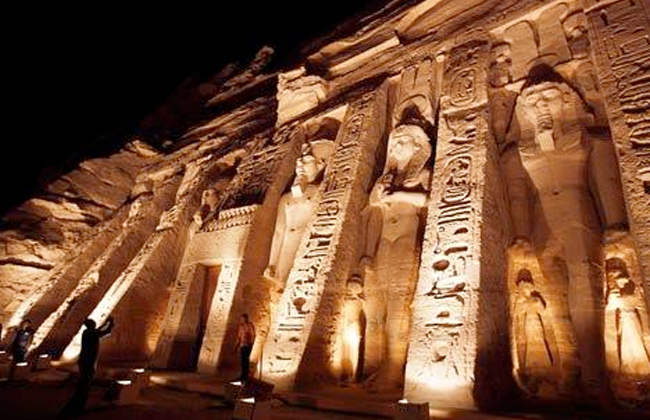Abu Simble Travel Guide
A Mesmerizing Escape in Egypt's Heartland
The Temple of Hathor: A Monument of Divine and Royal Splendor
Nestled in the formidable shadow of the colossal Great Temple of Ramses II at Abu Simbel lies a treasure of equal allure but distinct character—the Small Temple of Abu Simbel, or as it is reverently known, the Temple of Hathor. This enchanting edifice is dedicated to Hathor, the goddess of love and joy, and to Queen Nefertari, beloved wife of Ramses II. Unlike any typical tribute, this temple uniquely honors its royal and divine subjects side by side, reflecting the profound esteem Ramses held for his queen.

Majestic Entrance and Statuary
Upon approaching the temple, visitors are greeted by a striking facade, adorned with six statues that stand as silent sentinels to history and heritage. Prominently, Queen Nefertari is depicted at a monumental scale, matching that of Ramses himself—a rarity in Egyptian art that signifies her exceptional status. This statuary arrangement is unique for a Pharaonic temple, not only featuring the queen at the same height as the king but also flanked by smaller figures of their princes and princesses, reinforcing the familial aspect of this sacred space.

Interior Design and Symbolism
Step inside, and the interior continues to tell tales of reverence and celebration, albeit in a more subdued artistic language compared to its grand neighbor. Here, the walls vividly depict Nefertari and Ramses engaged in ritual acts, paying homage to the gods Hathor and Mut, with Nefertari herself elevated to a divine status, shining in celestial glory amidst the carvings. The hall, simpler yet significant, features six pillars adorned with the serene face of Hathor, adding a distinctive aesthetic to the temple’s design.
Warrior Imagery and Pillar Design
The interior not only honors the queen and the goddess but also showcases Ramses’s prowess as a warrior. Carvings of Ramses in battle adorn the walls, symbolizing his victories and strength. Unlike the Great Temple, this space is structured with three rows of two pillars each, all crowned with the image of Hathor, contributing to the temple’s unique ambiance.
Inner Sanctum and Surrounding Features
In the heart of the temple, a prominent carving of Hathor, depicted as a sacred cow-goddess, emerges from the Western Mountain, symbolizing rebirth and nurturing. Surrounding the antechamber, vivid depictions of Hathor in her sacred boat are complemented by side chambers that resemble caves, carved directly from the rock, enhancing the mythological narrative of the space.
Additional Monuments in the Vicinity
Beneath the temple cliffs, stones inscribed with the names of Nubian officials provide a glimpse into the administrative aspects of the era. Nearby, remnants of a sun-court near the Great Temple’s northern edge and a significant stele recording the marriage contract between Ramses II and a Hittite princess mark pivotal diplomatic and personal events in Ramses’s reign.
The Temple of Hathor at Abu Simbel stands not merely as an architectural feat but as a profound testament to the transcendent power of love and veneration that transcends the ages, inviting all who visit to wander through its halls and immerse themselves in its ancient, storied ambience. Whether you are a history buff, a lover of myths, or simply in awe of Egypt’s ancient architectural prowess, the Temple of Hathor offers a unique glimpse into the past where divine and earthly realms intertwine gracefully.
A very famous legend says that the temple and later on, the city was named Abu Simble after a local guy who was said led the archaeologists to discover the complex. A trip to Abu Simble is extremely recommended to any tourists who are fond of ancient Egyptian architecture, natural scenery, and Pharaonic history.
Created On March 18, 2020
Updated On september 1 , 2024







